INTRODUCTION
Overview of the species of interest
Rubus armeniacus, the Himalayan blackberry or Armenian blackberry, is a famous invasive species of the blackberry group. It is native to Armenia and Northern Iran. Over time, it has widely colonized most temperate zones across continents, specifically in forest edges, disturbed sites, and roadsides (Stannard, 2014). It is highly abundant in the west of the mountain ranges of the American Pacific Northwest (Jennings, 1988). After the introduction for cultivation in 1885, it out-competed many native shrub species (Caplan and Yeakley, 2006). Several life-history traits may contribute to its invasiveness in North America. Himalayan blackberry is mostly a biennial plant that prefers rich and well-drained soil. But it can grow on a variety of unfavorable sites (Brinkman, 1974) and has the ability to tolerate periodic flooding or shade. This species can be spread by seeds, roots, and stem fragments, birds and omnivorous mammals are the common dispersal helpers, and humans also contribute to blackberry spread by purposefully planting them as agricultural products.
The common starling (Sturnus vulgaris), also known as the European starling, is well-known for its highly-adaptive ability and abundant distribution. It is native in the temperate regions of Europe and western Asia. It was introduced to North America in 1890 (Mirsky, 2008). The global population of the European starling is estimated to be more than 310 million individuals (Linz et.al., 2007). European starlings migrate from regions where the winter weather is severe and food resources are scarce (Kessel, 1953). They occupy urban (Whitehead, Wright & Cotton, 1995) and agriculture habitats (Feare,1994) and feed on a wide range of invertebrates, as well as seeds and fruits (Witter, Swaddle & Cuthill, 1995). Their ability to adapt to a large variety of habitats and their successful reproduction strategy have allowed them to disperse and establish themselves in diverse locations around the world, resulting in a habitat range from coastal wetlands to alpine forests, sea cliffs to high mountain ranges(Feare,1994).
Objective
The species range map is the assessment of species distribution and dispersal patterns in a particular location. This map will provide information that helps to connect the geographical displacement with ecological, climate, and environmental factors. The species range map uses metadata, experimental results, ecological modeling, and taxonomic experts’ prediction to create a visual explanation of why species are found in particular habitats. However, there are many sources that produce different species range maps based on different data. As a result, the species information often shows inconsistency in the size and location of the distribution of such species. The differences between these species range maps may due to different data sources, identification errors, and observation times. The objective of this project is to analyze and compare differences among sources for European starling (Sturnus vulgaris) and Himalayan blackberry (Rubus armeniacus), and discuss the differences between the mapped distribution range of each species and the differences between distribution ranges of the bird and plant species.
METHODS
Species Selection
To explain the difference among sources, common starling (Sturnus vulgaris) and Himalayan blackberry (Rubus armeniacus) were chosen as the species of interest. The common starling was studied because it is well-known for its wide range of dispersal and fixed migration pattern, and this species itself is well-studied since its invasiveness caused many environmental problems. The range map of this bird species is predictable due to its known migration routes and season. Thus, the range map of common starling can reflect the importance of sampling time when making a range map. The Himalayan blackberry was studied because this species has a clear preference of climate zone and habitat type. The range map of this plant species can show the connection of distribution and habitat type, which will provide a good prediction on its future dispersal pattern.
Study Area
Both species are widely distributed around the world due to their extraordinary environmental adaptation ability, and their observed and predicted occurrence is densely distributed. According to GBIF (2020), Sturnus vulgaris has been observed and predicted to occur 10,671,944 times, whereas Rubus armeniacus has been observed and predicted to occur 13,534 times. This high volume of data is beyond the scope of this assignment. Thus, the study area was narrowed to the North American region to avoid computing limitations. In addition, since Sturnus vulgaris and Rubus armeniacus were introduced to North America at approximately the same time, their range map can provide some dispersal pattern that will help invasion management.
Data Collection
The species occurrence data were collected from three major databases including GBIF (2020), BISON (2019), eBird (2020), Map of life (2020), and iNaturalist(2020). Global Biodiversity Information Facility (GBIF) has been identified as the most qualified data source, thus the occurrence data from GBIF were used as the standard of comparison. Biodiversity Information Serving Our Nation (BISON) is the United States Federal Resource for Biological Occurrence Data, and it contains documented species occurrence records in North America. eBird is an online database that contains bird observation data from scientists, researchers, and naturalists, where the data describes bird species distribution and abundance. iNaturalist is an online science project that every observer can publish and report a species occurrence, and it provides real-time data with photos as evidence. However, not all observations on iNaturalist are verified by plant and animal experts, thus only confirmed data was used to avoid an error. In addition, different filters such as geographical location range and occurrence date were applied when collecting the data.
Table 1. Data used, and filter applied to each dataset.
| Species | Database | Filter |
| Himalayan blackberry Rubus armeniacus | GBIF | Location: North America; Type of record: observations and literature |
| BISON | Location: North America, Time limitation: before 1885 | |
| iNaturalist | Location: North America; Time range: January; Verified record | |
| Map of Life | Location: North America | |
| European starling Sturnus vulgaris | GBIF | Location: North America; Type of record: observations and literature |
| BISON | Location: North America; Time limitation: before 1890 | |
| iNaturalist | Location: North America; Time range: January; Verified record | |
| eBird | Location: North America |
Measurement
All the datasets were imported to Google Earth Pro and plotted according to their latitude and longitude as indicated in the Google Earth Help document (Henry, 2020). The estimated dispersal range of each species in each range map was measured using the polygon tool.
RESULT
Occurrence Analysis
Based on the reported occurrence of GBIF, BISON, iNaturalist, Map of Life, and eBird, the European starling population is found to be more abundant than Himalayan blackberry. The bird species has an average reported occurrence number of 6,887,017 in North America, whereas the plant species’ presence only has been observed 4,707 (average) times. When the time range filter applied to both species, European starling only had 37 specimen records in museums before being introduced to North America in 1890, and no Himalayan blackberry was observed in the wild or as a specimen before its introduction in 1885. However, the standard deviation of the plant species is calculated to be 1,753, which is much lesser than the standard deviation of 983,363 of the bird species. This result suggests that the difference of range among sources of plant species is less than a difference of range among sources of bird species.
Table 2. Occurrence data analysis of Rubus armeniacus and Sturnus vulgaris based on each database. The number represents the number of reported occurrences in each data source. Average and standard deviation were calculated to assessing the similarity and difference among each data source. Data before the introduction were included to show dispersal change after a massive invasion.
| Himalayan blackberry Rubus armeniacus | European starling Sturnus vulgaris | ||
| Database | Occurrence | Database | Occurrence |
| GBIF | 2,701 | GBIF | 7,560,841 |
| iNatrualist (without time limitation) | 5,479 | iNaturalist (without time limitation) | 5,758,604 |
| Map of Life | 2,393 | eBird | 7,341,606 |
| Average | 1,700 | Average | 6,887,017 |
| Standard deviation | 4,222 | Standard deviation | 983,363 |
| Before introduction in North America (1885) | 0 | Before introduction in North America (1890) | 37(specimen) |
Dispersal Range Analysis
In addition, based on the plotted occurrence on the map, the colonization region of Sturnus vulgaris is found to be wider than Rubus armeniacus. According to figure 1, as suggested by three databases, the dispersal area of European starling is significantly larger than the dispersal area of Himalayan blackberry.
Also, as shown in figure 2, the species of European starling is generally broader than the species range of Himalayan blackberry. The European starling is likely to be found in the southern part of Canada and all areas of the U.S. (fig. 2a), whereas Himalayan blackberry is likely to occupy the West Pacific Coastal region and Southeast of the U.S. (fig. 2e). In addition, the dispersal range of the bird is strongly affected by the season as expected, since a clear range difference can be observed in fig. 2a and fig. 2c. However, the season difference does not affect the dispersal of the plant species as less range difference shown in fig. 2d and fig. 2f. The range map of both species showed differences among sources.
Table 3. The estimated distribution range of Rubus armeniacus and Sturnus vulgaris based on each dataset. The area size was measured by Google Earth.
| Himalayan blackberry Rubus armeniacus | European starling Sturnus vulgaris | ||
| Database | Estimated Area | Database | Estimated Area |
| GBIF | 369,826 | GBIF | 12,060,178 |
| BISON (without time limitation) | 882,017 | BISON (without time limitation) | 6,609,995 |
| iNaturalist Jan. | 810,763 | iNaturalist Jan. | 3,850,310 |
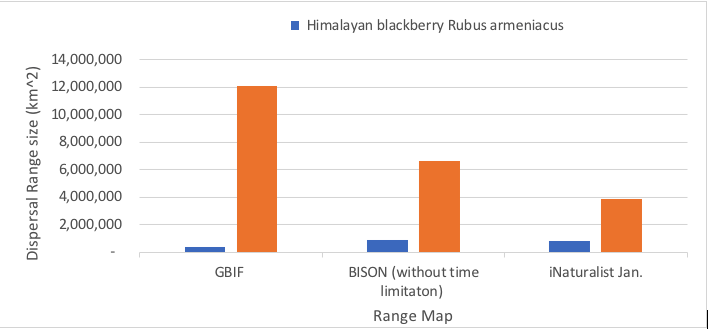
Figure 1. Comparison between range maps of Sturnus vulgaris and Rubus armeniacus. Each bar represents the average estimated dispersal area based on table 3.
A)
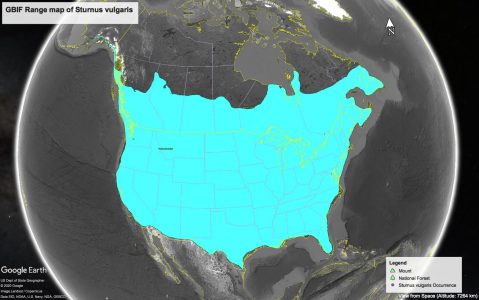
B)
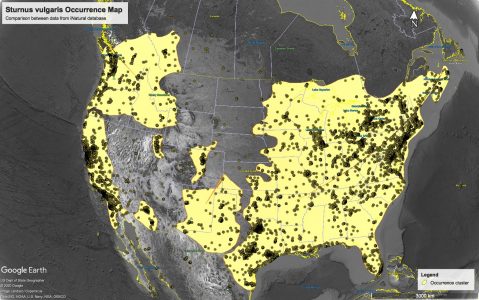
C)
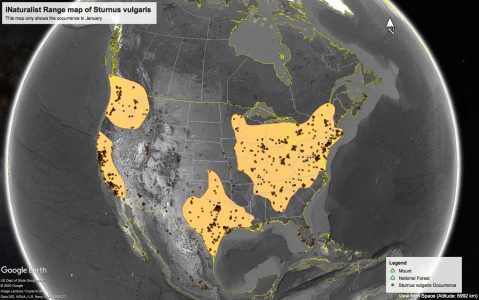
D)
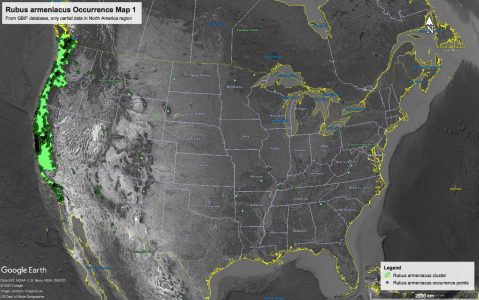
E)
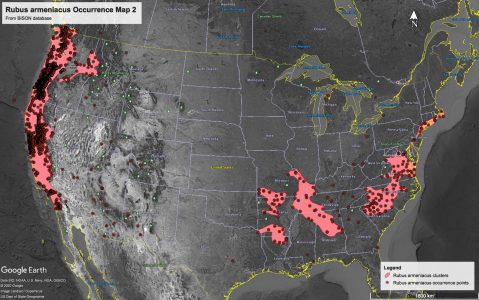
F)
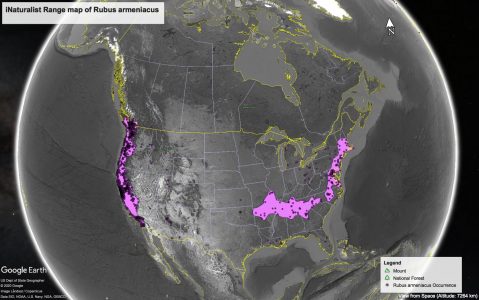
Figure 2. The species range map of Sturnus vulgaris and Rubus armeniacus. a) GBIF species range map of Sturnus vulgaris. The occurrence point data layer was hidden due to high abundance. b) BISON species range map of Sturnus vulgaris, no time range set to the data. c) iNaturalist species range map of Sturnus vulgaris occurrence during January. d) GBIF species range map of Rubus armeniacus. e) iNaturalist species range map of Rubus armeniacus, no time range set to the data. f) iNaturalist species range map of Rubus armeniacus occurrence during January. The full-size range maps are included in the appendix.
DISCUSSION
As different sources were used to make the range map of each species, the difference in dispersal density and area are shown as expected. GBIF was used as the referencing source and database to standardize the species occurrence since all the reported observation on GBIF was peer-reviewed and verified by experts. In addition, BISON, Map of Life, and eBird also use scientifically-reviewed sources of data, which increase their data reliability. The species range of the bird species is larger than that of the plant species as expected. Because birds are motile and migrate due to seasonal changes, while plant species are immobile. The expansion of the plant species range can only be achieved by reproduction and colonization. All the sources listed above provided a consistent result of the bird having a broader dispersal range with GBIF.
Range discrepancy can be introduced by including the wrong data from the unprofessional source. iNaturalist recorded twice as much of the Himalayan blackberry occurrence as GBIF, which is abnormally higher than expected. The major difference occurred in the Tennessee, Mississippi, and Alabama regions. The major reason for this is iNaturalist collect data from the public, thus not every source was verified to be correct. The morphology of Himalayan blackberry is very similar to cut-leaf blackberry (Rubus laciniatus), and wild blackberry (Rubus ulmifolius) (Finn, 2008), and it is also commonly believed to be Rubus discolor or Rubus procerus due to some taxonomy and nomenclature errors (Ceska, 1999). Therefore, some observers may miscategorize their observation to be the wrong species. Also, Himalayan blackberries have a preference of habitat in temperate zones (Stannard, 2014), though they can still tolerate unfavorable conditions, they are not likely to become abundant in such sites. According to the Koppen climate classification, the Pacific coastal region has a very distinct climate pattern from the Tennessee region (Beck et.al., 2005), which indicates some of the occurrences in the Tennessee, Mississippi, and Alabama region may not be very reliable.
Range discrepancy can also be introduced by presenting a map of the wrong time range or wrong seasons. Both species were introduced to North America around 1885, the dispersal ranges were slowly expanding from no record to thousands of records, thus, map the species range at the correct time is very important. The data of Himalayan blackberry at massive invasion status cannot be compared with European starling’s data when it is still expanding. In addition, the seasonal influence should also be taken into consideration when producing the range map of motile and migrating species. As observed, no presence of European starling was observed in Canada during the winter season, but more occurrences will be adapted when the range map was produced based on annual data. This is due to the migration of this bird species. According to Kessel (1953), the migration of European starlings ends in January of every year, during this time, more of this bird population will stay in the Southern area of North America. This will lead to a reduced species range in Canada during January and cause errors.
The reliable sources of species range maps have put many efforts to reduce the errors. They incorporate multiple databases to reduce errors caused by poor sampling. And literature review and geographic data are also consulted as a reference to avoid wrong observations. In addition, multiple filters can be selected to get rid of data of poor quality.
CONCLUSION
Generally, species range maps from different sources will have discrepancies on distributed area, location, and time. European starling Sturnus vulgaris is distributed in a wider range compared to Himalayan blackberry Rubus armeniacus, and its dispersal will be affected by its migration nature. Himalayan blackberry Rubus armeniacus tends to map incorrectly due to observation errors, but those wrong data can be eliminated by considering the geographic condition of the local habitat. No map is made perfectly, the species range can be influenced by many factors including data source, time, and also scale. Thus, more consideration and research are needed before making species range maps.
REFERENCE
Beck, C., Grieser, J., Kottek, M., Rubel, F., & Rudolf, B. (2005). Characterizing global climate change by means of Köppen climate classification. Klimastatusbericht, 51, 139-149.
BISON.usga.gov (2020) Rubus armeniacus Occurrence Download. Retrieved form https://bison.usgs.gov/download/d/file/bison-Rubus_armeniacus_1392585288_csv.zip
BISON.usga.gov (2020) Sturnus vulgaris Occurrence Download. Retrieved form https://bison.usgs.gov/download/d/file/bison-Sturnus_vulgaris_1735304683_csv.zip
Brinkman, K. A. (1974). Rubus L.--blackberry, raspberry. Agric Handb US Dep Agric.
Caplan, J. S., & Yeakley, J. A. (2006). Rubus armeniacus (Himalayan blackberry) occurrence and growth in relation to soil and light conditions in western Oregon. Northwest Science, 80(1), 9.
Ceska, A. (1999). Rubus armeniacus—a correct name for Himalayan blackberries. Botanical Electronic News, 230.
eBird.org (2020) Sturnus vulgaris Occurrence. Retrieved from https://ebird.org/species/eursta
Feare, C. F. (1994). Changes in numbers of common starlings and farming practice in Lincolnshire. British Birds, 87(5), 200-204.
Finn, C. E. (2008). Rubus spp., blackberry. The encyclopedia of fruits and nuts, 348-351.
GBIF.org (2020) GBIF Rubus armeniacus Occurrence Download https://doi.org/10.15468/dl.6arroc
GBIF.org (2020) GBIF Sturnus vulgaris Occurrence Download https://doi.org/10.15468/dl.2pryvw
Henry, G. (2020). Google Earth Help [Assignment resources]. Retrieved from https://canvas.ubc.ca/courses/37101/assignments/461113
iNatrualist (2020) Rubus armeniacus Occurrence Download. Retrieved form https://www.inaturalist.org/observations/export?flow_task_id=80022
iNatrualist (2020) Sturnus vulgaris Occurrence Download. Retrieved form https://www.inaturalist.org/observations?place_id=97394&taxon_id=14850
Jennings, D. L. (1988). Raspberries and blackberries: their breeding, diseases and growth. Academic press.
Kessel, B. (1953). Distribution and migration of the European Starling in North America. The Condor, 55(2), 49-67.
Linz, G. M., Homan, H. J., Gaulker, S. M., Penry, L. B., & Bleier, W. J. (2007). European starlings: a review of an invasive species with far-reaching impacts.
Map of Life.org (2020) Rubus armeniacus Occurrence. Retrieved form https://mol.org/species/map/Rubus_armeniacus
Mirsky, S. (2008). Shakespeare to blame for introduction of European starlings to US. Scientific American, 1.
Stannard M.E. (2014). Plant guide for Himalayan blackberry (Rubus armeniacus). Pullman, Washington, USA: USDA-Natural Resources Conservation Service, Plant Materials Center, 3 pp.
Whitehead, S. C., Wright, J., & Cotton, P. A. (1995). Winter field use by the European starling Sturnus vulgaris: habitat preferences and the availability of prey. Journal of Avian Biology, 193-202.
Witter, M. S., Swaddle, J. P., & Cuthill, I. C. (1995). Periodic food availability and strategic regulation of body mass in the European starling, Sturnus vulgaris. Functional ecology, 568-574.
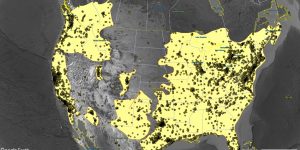
Learning Significance